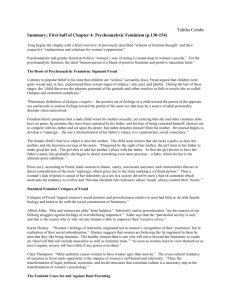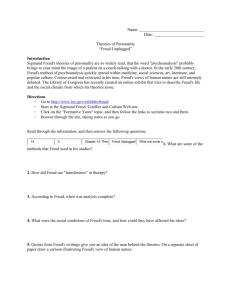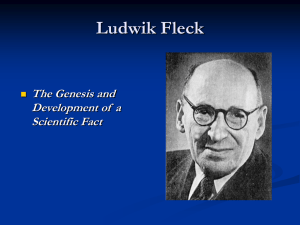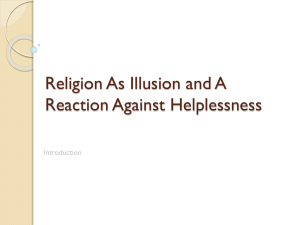Psychoanalytic Theory
advertisement
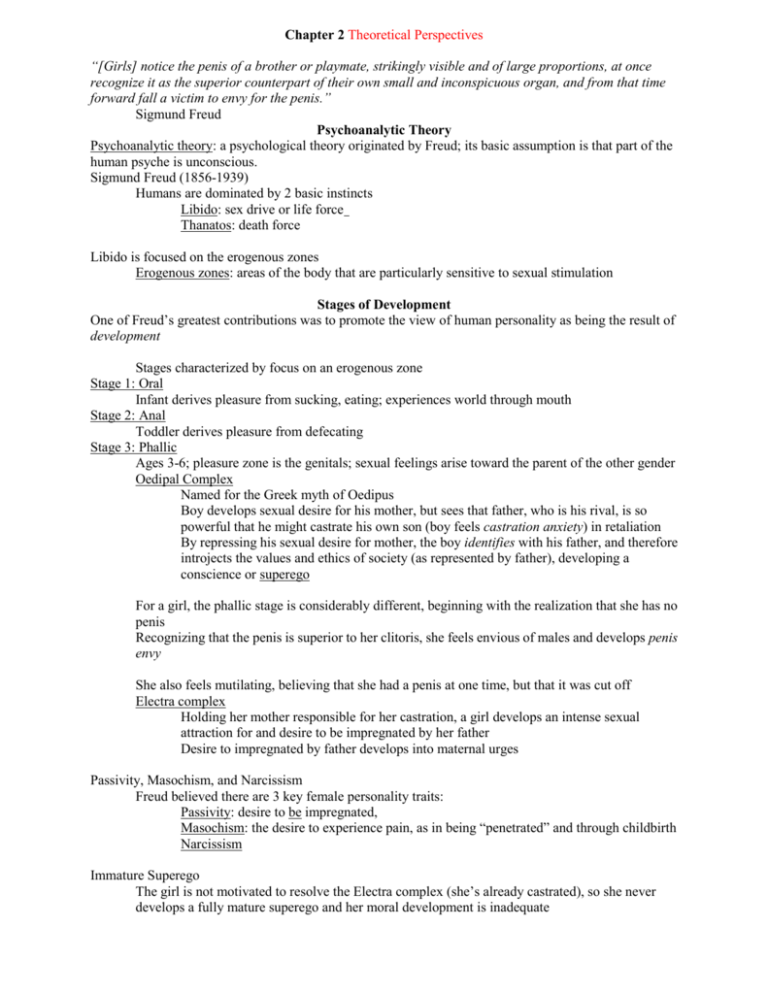
Chapter 2 Theoretical Perspectives “[Girls] notice the penis of a brother or playmate, strikingly visible and of large proportions, at once recognize it as the superior counterpart of their own small and inconspicuous organ, and from that time forward fall a victim to envy for the penis.” Sigmund Freud Psychoanalytic Theory Psychoanalytic theory: a psychological theory originated by Freud; its basic assumption is that part of the human psyche is unconscious. Sigmund Freud (1856-1939) Humans are dominated by 2 basic instincts Libido: sex drive or life force Thanatos: death force Libido is focused on the erogenous zones Erogenous zones: areas of the body that are particularly sensitive to sexual stimulation Stages of Development One of Freud’s greatest contributions was to promote the view of human personality as being the result of development Stages characterized by focus on an erogenous zone Stage 1: Oral Infant derives pleasure from sucking, eating; experiences world through mouth Stage 2: Anal Toddler derives pleasure from defecating Stage 3: Phallic Ages 3-6; pleasure zone is the genitals; sexual feelings arise toward the parent of the other gender Oedipal Complex Named for the Greek myth of Oedipus Boy develops sexual desire for his mother, but sees that father, who is his rival, is so powerful that he might castrate his own son (boy feels castration anxiety) in retaliation By repressing his sexual desire for mother, the boy identifies with his father, and therefore introjects the values and ethics of society (as represented by father), developing a conscience or superego For a girl, the phallic stage is considerably different, beginning with the realization that she has no penis Recognizing that the penis is superior to her clitoris, she feels envious of males and develops penis envy She also feels mutilating, believing that she had a penis at one time, but that it was cut off Electra complex Holding her mother responsible for her castration, a girl develops an intense sexual attraction for and desire to be impregnated by her father Desire to impregnated by father develops into maternal urges Passivity, Masochism, and Narcissism Freud believed there are 3 key female personality traits: Passivity: desire to be impregnated, Masochism: the desire to experience pain, as in being “penetrated” and through childbirth Narcissism Immature Superego The girl is not motivated to resolve the Electra complex (she’s already castrated), so she never develops a fully mature superego and her moral development is inadequate Thus, she maintains lifelong feelings of inferiority, a predisposition to jealousy, and intense maternal desires Freud (1948): “Their [girls’] superego is never so inexorable, so impersonal, so independent of its emotional origins as we require it to be in men.” Criticisms of Psychoanalytic Theory Concepts cannot be evaluated scientifically to determine accuracy (how do we measure the unconscious?) Freud derived his ideas from work with patients who sought therapy; his theory describes disturbed, not normal, behavior Freud overemphasized biological determinants of human behavior in seeing origins of gender differences as rooted in anatomical differences Freud’s views are phallocentric (male centered, penis centered), assuming that the vagina and clitoris are inferior to the penis Phallocentric theory is an example of a male-as-normative, androcentric model in psychology Variations on a Freudian Theme: Karen Horney (1885-1952) Importance of penis envy was overstated, that the critical factor was actually womb envy, male’s envy of woman’s uterus and reproductive capacity Male achievement represents overcompensation for feelings of anatomical inferiority Emphasized cultural and social influences and human growth Variations on a Freudian Theme: Helene Deutsch (1884-1982) The Psychology of Women (1944) Extended Freud’s theory to later development, focusing on motherhood Focused on “feminine core” of personality, including narcissism, masochism, passivity, instinct, and intuition Masculinity complex: some women’s failure to adjust, seen in aggression, active masculine tendencies Variations on a Freudian Theme: Anna Freud (1895-1982) Youngest of Sigmund Freud’s children, but only child to continue father’s work Enormous impact on field of psychoanalysis: founding child psychoanalysis and play therapy Founded a school for orphaned children during WWII, studying their behavior Variations on a Freudian Theme: Nancy Chodorow The Reproduction of Mothering (1978) Childcare done by women produces vastly different experiences for daughters than for sons; daughters want to mother, sons devalue and dominate women The early, intensely close relationship with the mother affects the sense of self and attitudes toward women: expect women to be caring, self-sacrificing Girl sees similarity to mother, defines self in relational terms, but boys define masculinity as non-femininity, and thus devalue women Mothering perpetuates itself and the gendered division of labor Chodorow’s work integrates feminism Feminist reconstruction of Freudian theory: penis envy stems from the fact that the penis symbolizes the power men have in our society Prescription for social change to eliminate inequities for women: men must participate equally in childcare to break cycle of female devaluation Testing Chodorow’s Theory Mother-daughter pairs are physically and psychologically closer than mother-son pairs Criticisms of Chodorow’s Theory Heterosexist bias: no attempt to understand lesbian development Ignores influences of race and social class Like Freud, Chodorow’s evidence stems from observations of clinical population Sociobiology & Evolutionary Psychology Sociobiology: application of evolutionary theory to explaining the social behavior of animals, including people. Initially proposed by E.O. Wilson (1975) E.g., how does evolution shape maternal behavior? Review evolution by natural selection… Evolution by Natural Selection First proposed by Charles Darwin (1881) The process by which the fittest animals survive, reproduce, and pass their genes on to the next generation, whereas animals that are less fit do not reproduce and therefore do not pass on their genes Central theorem of sociobiology: When a social behavior is genetically influenced, the animal should behave so as to maximize fitness. Parental investment: behaviors or other investments in the offspring by the parent that increase the offspring’s chance of survival Importance to psychology of women: Females invest egg, pregnancy, nursing... But males must invest only sperm Parent with greater investment should care for young—quality, not quantity Other parent should try to produce as many offspring as possible—quantity, not quality Why do women do the childcare? Greater parental investment Maternity is always certain, paternity is not Exception to pattern of maternal care: Songbirds: equal participation in care of young; monogamous mating system makes paternity certain Explaining female orgasm… Babies are born helpless, dependent, in need of care Monogamous mating systems are adaptive Female orgasm evolved to keep the parents together Explaining the double standard… Tolerance of male promiscuity and disapproval of female promiscuity is adaptive, given the gender differences in parental investment Sexual selection: process by which members of one gender (usually males) compete with each other for mating privileges with members of the other gender (usually females), and members of the other gender (females) choose to mate only with certain preferred members of the first gender (males) Evolutionary psychology (Buss, 1995) Humans’ complex psychological mechanisms are the result of evolution based on natural selection Sexual strategies theory: women and men had different short- and long-term mating strategies It is to men’s evolutionary advantage to inseminate many women, so they invest in short-term mating (especially because they can’t be certain of paternity), preferring younger women who are at peak fertility Because women have greater parental investment, they put energy into long-term mating strategies to ensure a man’s commitment to provide for family, preferring men who possess resources Feminist criticisms Biology is often a convenient rationalization for perpetuating the status quo Sociobiologists view data from an androcentric perspective, only discussing data that support their androcentric theories Sociobiology rests on an outmoded version of evolutionary theory that modern biologists consider naïve Many studies contradicting evolutionary psychology are beginning to emerge Eagly & Wood (1999) re-analyzed Buss’s cross-cultural data and proposed an alternative to his sexual strategies theory Social-structural theory: a theory of the origin of psychological gender differences that focuses on the social structure, particularly the division of labor between men and women Social Learning Theory Principles of operant conditioning explain the acquisition of gender roles The mechanisms of social learning theory: Reinforcement: something that occurs after a behavior and makes the behavior more likely to occur in the future Imitation: when people do what they see others doing; we imitate same-gender adults more than other-gender adults Observational learning: when a person observes someone doing something, and then does it at a later time; Evidence for social learning theory: Effectiveness of imitation and reinforcements in shaping children’s behavior, in particular gender-typed behaviors such as aggression Bandura (1965) found boys to be more aggressive than girls gender differences disappeared when children were offered reinforcements for being aggressive Cognitive-Developmental Theory Piaget & Inhelder: children have different cognitive organization from adults Gender identity: individual’s knowledge that she or he is a female or male; develops ~18-24 mos Gender constancy: child’s understanding that gender is a permanent, unchanging characteristic of the self; develops ~5-7 yrs; crucial for adoption of gender roles Gender-role learning as one aspect of cognitive development Children self-socialize based on gender constancy Evaluation of theory Children who have acquired gender constancy imitate same-gender models Preschoolers who have acquired gender constancy are more stereotyped in their views of adult occupations than are preschoolers who do not have gender constancy But, children’s gender-typed interests appear before gender constancy (~ 2-3 yrs) Gender Schema Theory Gender Schema Theory A father and his son were involved in a car accident in which the father was killed and the son was seriously injured. The father was pronounced dead at the scene of the accident and his body was taken to a local mortuary. The son was taken by ambulance to a hospital and was immediately wheeled into an operating room. A surgeon was called. Upon seeing the patient, the attending surgeon exclaimed, “Oh my God, it’s my son!” Can you explain this? A schema is a general knowledge framework that a person has about a particular topic; it processes, organizes new information on topic Our perception and memory of information are a result of an interaction of incoming information with our preexisting schema A gender schema (Bem, 1981) is a person’s general knowledge framework about gender; it processes and organizes information on the basis of gender-linked associations Gender schemas are closely linked to our self-concept A girl’s self-esteem is dependent on how well she measures up to her girl schema Different individuals have, to some extent, different gender schemas The gender schema is more central to self-concept for some people—those who are highly gender-typed Evidence for gender schema theory 5- and 6-year olds tend to remember the picture on the left but distort the picture on the right so it’s stereotype-consistent Feminist Theories Gender as status and power Gender is a class variable in our society; males and females are unequal in status Sexism is pervasive, existing in political, academic, economic, and interpersonal spheres Men have greater power than women The personal is political: personal, individual experiences are manifestations of larger political issues Sexuality A central issue for feminism because women’s sexuality has been repressed and depressed, but rarely expressed Women’s sexuality is controlled by men Gender roles and socialization American society has well-defined roles for males and for females; such roles are constricting to individuals External vs. internal attributions of problems Feminists view the sources of women’s problems as being external Consciousness raising Major technique of analysis, structure of organization, method of practice, and theory of social change of the women’s movement (MacKinnon, 1982) Focus on seeing personal experiences in larger political context Varieties of feminism: Liberal feminism: women should have the opportunities and rights equal to those of men; work to reform current system Cultural feminism: women have special, unique qualities that differentiate them from men; our patriarchal society devalues those qualities Marxist feminism: oppression of women is just one instance of oppression based on class, rooted in capitalism Radical feminism: patriarchal values have saturated society to such an extent that radical changes are needed, such as female-only space safe from oppression Postmodern feminism: questions rationality and objectivity as methods for getting at truth; advocates social constructionist epistemology Gender, race/ethnicity, and class Gender cannot be understood as a social variable in isolation; it can be understood only in the context of race and social class as well Social construction of gender Social constructionism: theoretical viewpoint that humans do not discover reality directly; rather, they construct meanings for events in the environment based on own prior experiences and beliefs Attitudes toward feminism 21% of women think of selves as feminists 75% of women think feminism improved lives Humanism Research/Application Although humanistic psychologists sometimes do not focus empirical research, research on topics introduced or promoted by these psychologists has provided insight into some important aspects of humanistic personality theory. Research on self-disclosure finds that people follow social rules concerning when and how to reveal information about themselves Self disclosure: act of revealing intimate information about oneself to another person. The rule of Disclosure Reciprocity: matching a conversation partner’s self-disclosing intimacy level. 2 people getting acquainted in conversation are likely to reveal information about themselves at roughly the same level of intimacy. Friends who have already shared intimate information in a reciprocal manner do not always return to this pattern. Self-disclosure: allows people to better understand themselves; allows people to grow emotionally and move toward self-actualization Studies with couples in long-term romantic relationships find that self-disclosure in a marriage is a reliable predictor of marital satisfaction. Other studies find men and women are restricted in what they disclose by what society deems appropriate—gender appropriate. Females tend to self-disclose more than males. Holding traumatic secrets inside may take its toll on a person’s health. . There are health benefits of disclosing traumatic information. Loneliness is not the same as isolation. Researchers define loneliness as a discrepancy between the amount and quality of social contact we desire and the amount and quality we receive. How well the amount and quality of our relationships with others satisfies our personal needs—defines loneliness. Unpleasant feelings brought about by a perceived discrepancy between desired and achieved social interaction. Although loneliness is influenced by social situations, people tend to suffer from loneliness at a fairly stable level. Lonely people appear to show little interest in getting to know others. May lack social skills, and thus have difficulty developing relationships Research suggests that the majority of college students experience loneliness on occasion Research on chronically lonely people indicates they approach conversations with negative expectations and lack some basic social skills. Because of this tendency, they inadvertently stifle social interactions and discourage potential friends. Contrast loneliness with isolation High and low self-esteem people react differently to failure. Low self-esteem people become discouraged and unmotivated when they receive negative feedback, whereas high self-esteem people employ tactics to blunt the effects of failure. high self-esteem people often motivated by a concern for self-enhancement; low self-esteem people are often more concerned about self-protection. People differ in the extent to which feeling of self-worth fluctuates---this individual difference is self-esteem stability. Recent research indicates that notions about the self and self-esteem taken from individualistic cultures may not apply to collectivist cultures. Maslow observed that virtually all of his psychologically healthy people reported a high preference for solitude. Subsequent research finds that most people spend a large percentage of their time in solitude. Although people typically find this time unpleasant, others seek out and enjoy their time alone. Researchers find that people differ in the extent to which they prefer solitude. People with a high preference for solitude enjoy their time alone but also enjoy time spent with others. disclosure reciprocity Matching a conversation partner's self-disclosing intimacy level. loneliness Unpleasant feelings brought about by a perceived discrepancy between desired and achieved social interaction. preference for solitude The extent to which people seek out and enjoy time alone. self-disclosure The act of revealing intimate information about oneself to another person. self-esteem Evaluation of one's self-concept, usually measured in terms of a relatively stable and global assessment of how a person feels about himself or herself. self-esteem stability The extent to which an individual's feelings of self-worth fluctuate. THEORIES OF HUMAN DEVELOPMENT Schaffer THE NATURE OF SCIENTIFIC THEORIES Theory – set of concepts and propositions that describe and explain observations Parsimonious: concise Falsifiable: capable of making specific predictions which can be disconfirmed Heuristic: build on existing knowledge by generating testable hypotheses THE PSYCHOANALYTIC VIEWPOINT Freud’s Psychosexual Theory Unconscious motives are repressed Development is a conflictual process Sexual and aggressive instincts that must be served, yet society dictates restraint Three Components of Personality Id: satisfy inborn biological instincts, now Ego: conscious, rational, finds a realistic means of satisfying instincts Superego: seat of the conscience, develops between ages 3-6 as morals of parents are internalized Stages of Psychosexual Development Sex instinct, broadly defined, was most important Focus of sex instinct shifts during development Shifts = stages Contributions Unconscious motivation Impact of early experiences Emotional side of development Criticisms Little evidence that oral, anal, and genital conflicts predict adult personality Difficulty falsifying or confirming main propositions THE PSYCHOANALYTIC VIEWPOINT Erickson’s Theory of Psychosocial Development Comparing Erickson with Freud Children are active explorers, not passive slaves to biological urges Emphasis on social and cultural influences, less on sexual urges Eight Life Crises (Psychosocial Stages) Emerge at a time dictated by biological maturation and social demands Must be resolved successfully for satisfactory resolution at next stage Extend throughout life Contributions Stresses rational, adaptive nature Emphasizes social conflicts that we can anticipate and observe in others Criticisms Vague about causes of development Descriptive, not explanatory THE PSYCHOANALYTIC VIEWPOINT Psychoanalytic Theory Beyond Freud and Erickson Horney – founder of psychology of women Adler – siblings are important contributors to social and personality development Sullivan – close, same-sex friendships during middle childhood set stage for intimate love relationships later in life THE LEARNING VIEWPOINT Bandura’s Cognitive Social Learning Theory People are active information processors Observational learning – observing models Rejects Watson’s environmental determinism – passive recipients Proposed reciprocal determinism – interaction between person, behavior, and the environment (bidirectional links) Bandura’s classic “Bobo Doll” Study Demonstrated importance of observational learning Demonstrated no-trial learning Distinguished learning from performance Contributions of Learning Theories Wealth of information Very precise and testable Clinical insights and practical applications Behavior modification Criticisms of Learning Theories Oversimplified, ignores contribution of biological influences Children must be studied in their natural settings to understand how environments influence development Too little attention on cognitive influences on development COGNITIVE-DEVELOPMENTAL VIEWPOINT Piaget’s View of Intelligence Intelligence: a process that helps an organism adapt to its environment Scheme: organized pattern of thought or action used to cope with or explain experience Children actively construct understandings of the world through experience. Assimilation: interpretation of new experiences in terms of existing schemes Disequilibrium: contradictions between understanding and facts Accommodation: alter existing schemes to account for new experiences Four Stages of Cognitive Development Sensorimotor (0-2) Preoperational (2-7) Concrete-operational (7-11/12) Formal operational (11/12 – beyond) Invariant developmental sequence Piaget’s Viewpoint Contributions Legitimized study of children’s thinking Contributed to new area of social cognition Strong impact on education Discovery based learning Criticisms Underestimated young children’s intellectual capacities Training can improve performance on tasks, challenging the assumption that individualized discovery learning is best. Sociocultural Influences: Vygotsky’s viewpoint How is culture transmitted from generation to generation? Cognitive growth is a socially mediated activity. Not all children progress through same stages of cognitive growth, some are culturally specific. The Information-Processing Viewpoint The mind is like a computer; information flows in, is operated on, and is converted to output (answers etc.). Cognitive development Changes in brain and mental processes Due to both maturation and experience Is continuous, NOT stagelike Contributions Insights on growth of cognitive abilities Filled gaps in Piaget’s theory Know how children approach problems Know why they make errors Can suggest strategies to improve performance Criticisms May not reflect thinking in everyday life Computer model may underestimate the richness/diversity of cognition Both are being addressed by researchers THE ETHOLOGICAL AND EVOLUTIONARY VIEWPOINTS Ethology: scientific study of evolutionary basis of behavior and the contributions of evolved responses to survival and development Assumptions of Classical Ethology: Born with biologically programmed behaviors (through natural selection) Products of evolution Adaptive to survival Focus on instinctual responses that All members of species share May steer individuals along similar developmental paths Study subjects in natural environment Ethology and Human Development Crying (for example) Ensures infant’s basic needs are met Ensures sufficient contact to form primary emotional attachments Critical periods: limited time span when organisms are biologically prepared to display adaptive patterns of development, given right input Sensitive periods: Optimal time for emergence of behaviors Particularly sensitive to environmental influences Development can occur outside a sensitive period, but is more difficult Modern Evolutionary Theory Adaptive motives and behaviors ensure survival and spread of an individual’s genes Individual can die if family member survives, as they carry his or her genes Contributions Children have adaptive, genetically preprogrammed characteristics that influence development. Value of studying human development in normal, everyday settings Value of comparing human development with that of other species Criticisms Difficult to test Learning tends to modify most biological predispositions Bronfenbrenner – ecological systems theory: a detailed analysis of environmental influences Contexts for Development Natural environments are the major source of influence for development. Environment is a set of nested structures. Bronfenbrenner’s ecological model of the environment as a series of nested structures. The microsystem refers to relations between the child and the immediate environment, the mesosystem to connections among the child’s immediate settings, the exosystem to social settings that affect but do not contain the child, and the macrosystem to the overarching ideology of the culture Bronfenbrenner’s Contexts for Development Microsystem: activities/interactions in the immediate surroundings Mesosystem: connections between microsystems (homes, schools, etc.) Exosystem: contexts children are not a part of but which may influence development Macrosystem: cultural, subcultural, or social class context in which other systems are imbedded Chronosystem: changes in the child or any of the other systems can affect the direction of development Contributions Rich description of environment Need to study development in natural settings Criticisms Little on specific biological contributors Lack of focus on normative development THEMES IN THE STUDY OF HUMAN DEVELOPMENT The Nature/Nurture Theme Biological versus environmental forces Both interact to produce change The Active/Passive Theme Children are active, determining how society treats them Children are passive, being molded by society The Continuity/Discontinuity Theme Change occurs gradually and continuously or with abrupt changes or stages (discontinuous) Quantitative or qualitative changes Quantitative: change in degree or amount qualitative: changes in form or kind The Holistic Nature of Development Issue Are the different aspects of development separate, or are they interrelated and influence each other?
